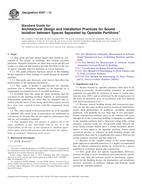We need your consent to use the individual data so that you can see information about your interests, among other things. Click "OK" to give your consent.
ASTM E557-12
Standard Guide for Architectural Design and Installation Practices for Sound Isolation between Spaces Separated by Operable Partitions
STANDARD published on 1.4.2012
The information about the standard:
Designation standards: ASTM E557-12
Note: WITHDRAWN
Publication date standards: 1.4.2012
SKU: NS-47197
The number of pages: 7
Approximate weight : 21 g (0.05 lbs)
Country: American technical standard
Category: Technical standards ASTM
The category - similar standards:
Annotation of standard text ASTM E557-12 :
Keywords:
acoustical, design, installation, movable, operable, partition, sound , Acoustical materials/applications, Installation--acoustic materials, Operable partition, Partitions, ICS Number Code 91.060.10 (Walls. Partitions. Facades)
Additional information
| Significance and Use | ||||||||||
|
Rooms formed by operable partitions often need to be isolated acoustically. Sound-isolating properties of operable partitions are specified by architects in terms of sound transmission class (STC) and so advertised by the manufacturer on the basis of laboratory tests in accordance with Test Method E90 and Classification E413. Because normal building design and construction practices are not the same as those used in acoustical laboratories, actual field performance of partitions, including operable partitions, will probably be less than that of test specimens. Sound transmission between areas to be isolated will occur through all of the connecting building components in addition to the operable partition, that is, floor and ceiling slabs, ceiling plenums, common walls, etc. All possible paths between the areas being isolated should have a sound insulation performance at least equal to the operable partition. Unless good acoustical practice is followed in both building design and installation, there may be a significant discrepancy between the sound isolation expected and that achieved. Because of the complex nature of the sound flanking paths adjacent to operable partitions, it is highly recommended that all related construction details be reviewed by a person qualified in acoustical design and construction. This guide does not specify requirements. However, persons desiring to write installation and construction specifications may find the contents useful in developing requirements for the building design site preparation, and installation practices necessary to minimize leakage and flanking sound around the operable partition. |
||||||||||
| 1. Scope | ||||||||||
|
1.1 This guide provides design details that should be considered in the design of buildings that include operable partitions. Operable partitions are those that can be quickly put in place or removed and stored to provide flexibility in the size of spaces typically used for meetings or social functions. 1.1.1 The guide primarily discusses details in the building design required to limit leakage of sound around an operable partition. 1.1.2 The guide also discusses some factors that affect the performance of the partitions themselves. 1.1.3 This guide is neither a specification for operable partitions nor a document intended to be imposed as a requirement on manufacturers of operable partitions. 1.2 Excluded from this guide are those partitions that are classified by the building products industry as demountable. Demountable partitions are those that are designed and installed with the intent of later being taken down and re-erected by a crew over a period of time, with the components being reusable. 1.3 The values stated in inch-pound units are to be regarded as standard. The values given in parentheses are mathematical conversions to SI units that are provided for information only and are not considered standard. 1.4 This standard does not purport to address all of the safety problems, if any, associated with its use. It is the responsibility of the user of this standard to establish appropriate safety and health practices and determine the applicability of regulatory limitations prior to use. |
||||||||||
| 2. Referenced Documents | ||||||||||
|
Similar standards:
Historical
15.7.2014
Historical
15.7.2013
Historical
1.12.2011
Historical
1.6.2014
Historical
1.1.2014
Historical
1.2.2009
We recommend:
Technical standards updating
Do you want to make sure you use only the valid technical standards?
We can offer you a solution which will provide you a monthly overview concerning the updating of standards which you use.
Would you like to know more? Look at this page.



 ASTM E2707-14
ASTM E2707-14 ASTM E2837-13
ASTM E2837-13 ASTM E2841-11
ASTM E2841-11 ASTM E2925-14
ASTM E2925-14 ASTM E330/E330M-14..
ASTM E330/E330M-14.. ASTM E331-00(2009)..
ASTM E331-00(2009)..
 Cookies
Cookies
